MEMS Micromirror Actuation Techniques: A Comprehensive Review of Trends, Innovations, and Future Prospects
Abstract
1. Introduction
2. Electrostatic Actuation
2.1. Parallel Plate ESA-Based Micromirrors
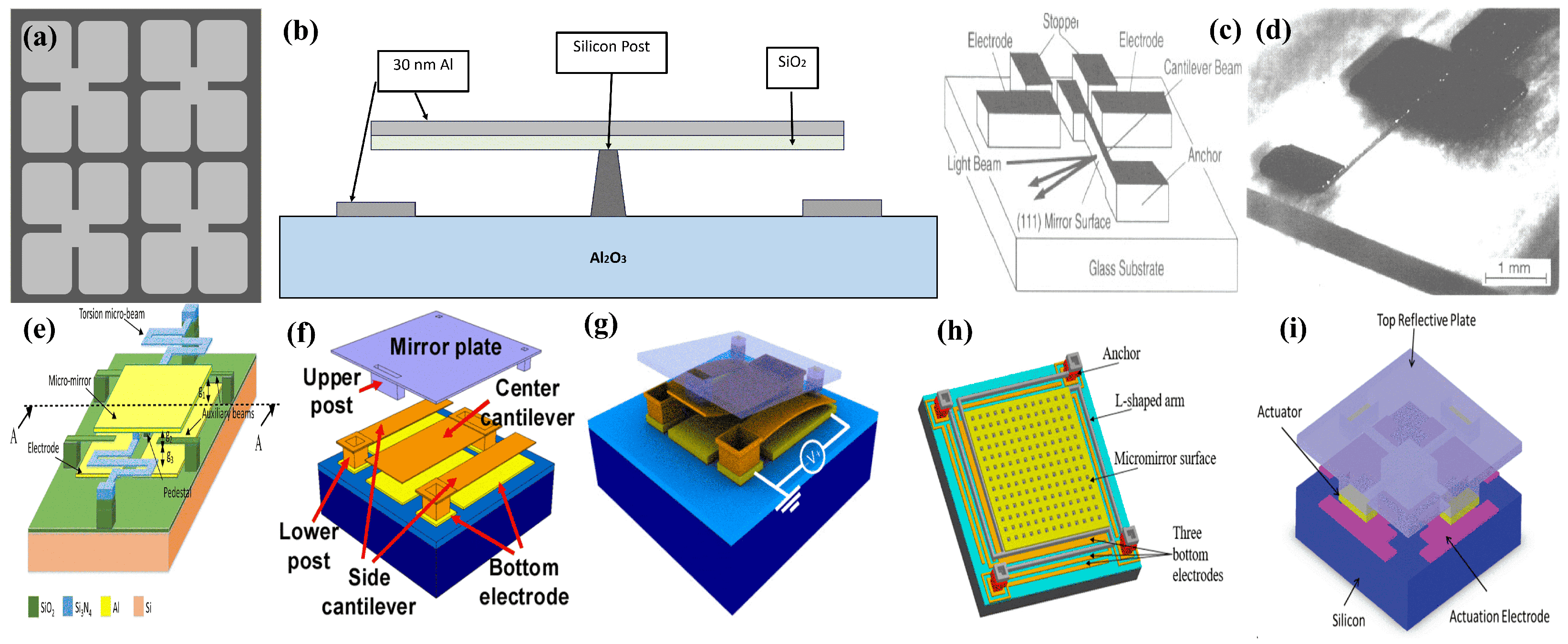
2.2. Combdrive ESA
3. Electrothermal Actuation-Based Micromirrors
3.1. Monomorphic Electrothermal Actuators
3.2. Bimorphic Electrothermal Actuators
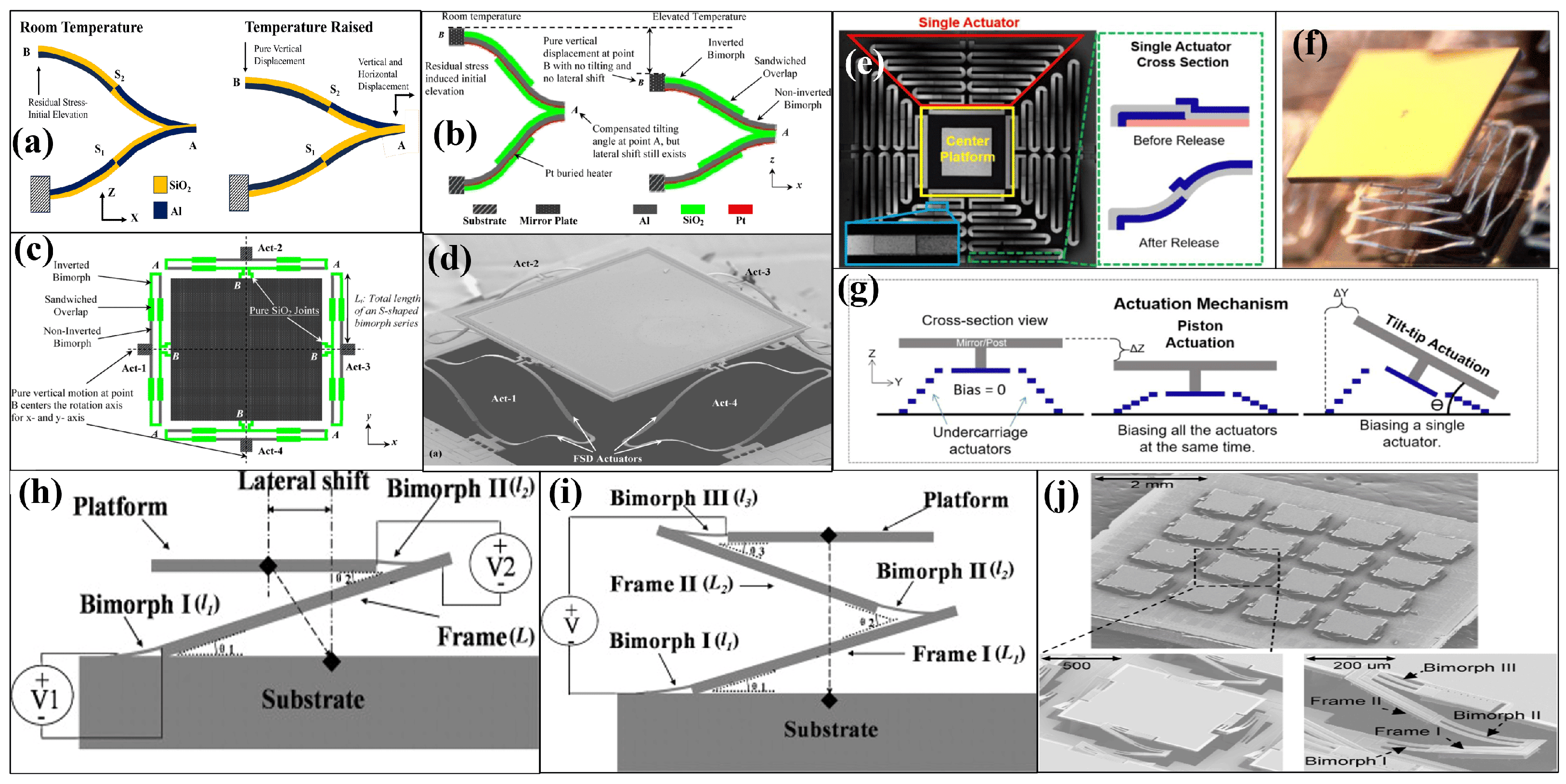
4. Electromagnetic Actuation
5. Piezoelectric Actuation
6. Hybrid Actuators Based Micromirrors
7. Discussion
7.1. Key Characteristics
7.2. Advantages and Trade-Offs
7.3. Limitations and Research Gap
7.4. Validation and Sensitivity Analysis
7.5. Summary
8. Conclusions
Author Contributions
Funding
Acknowledgments
Conflicts of Interest
References
- Ra, H.; Piyawattanametha, W.; Taguchi, Y.; Lee, D.; Mandella, M.J.; Solgaard, O. Two-dimensional MEMS scanner for dual-axes confocal microscopy. J. Microelectromech. Syst. 2007, 16, 969–976. [Google Scholar] [CrossRef]
- Jung, I.W.; López, D.; Qiu, Z.; Piyawattanametha, W. 2-D MEMS scanner for handheld multispectral dual-axis confocal microscopes. J. Microelectromech. Syst. 2018, 27, 605–612. [Google Scholar] [CrossRef]
- Guldberg, J.; Nathanson, H.; Balthis, D.; Jensen, A. An aluminum/SiO2/silicon- on- sapphire light valve matrix for projection displays. Appl. Phys. Lett. 1975, 26, 391–393. [Google Scholar] [CrossRef]
- Manh, C.H.; Hane, K. Vacuum operation of comb-drive micro display mirrors. J. Micromech. Microeng. 2009, 19, 105018. [Google Scholar] [CrossRef]
- Ju, S.; Jeong, H.; Park, J.H.; Bu, J.U.; Ji, C.H. Electromagnetic 2D scanning micromirror for high definition laser projection displays. IEEE Photonics Technol. Lett. 2018, 30, 2072–2075. [Google Scholar] [CrossRef]
- Baran, U.; Brown, D.; Holmstrom, S.; Balma, D.; Davis, W.O.; Muralt, P.; Urey, H. Resonant PZT MEMS scanner for high-resolution displays. J. Microelectromech. Syst. 2012, 21, 1303–1310. [Google Scholar] [CrossRef]
- Farrell, J.D.; Wang, J.; MacDougall, D.; Yang, X.; Brewer, K.; Couvreur, F.; Shoman, N.; Morris, D.P.; Adamson, R.B. Geometrically accurate real-time volumetric visualization of the middle ear using optical coherence tomography. Biomed. Opt. Express 2023, 14, 3152–3171. [Google Scholar] [CrossRef]
- Liu, T.; Pan, T.; Wang, P.; Qin, S.; Xie, H. Scanning optimization of an electrothermally-actuated MEMS mirror for applications in optical coherence tomography endoscopy. Sensors Actuators A Phys. 2022, 335, 113377. [Google Scholar] [CrossRef]
- Gorecki, C.; Bargiel, S. MEMS scanning mirrors for optical coherence tomography. Photonics 2020, 8, 6. [Google Scholar] [CrossRef]
- Chen, Q.; Zhao, H.; Qi, T.; Wang, H.; Xie, H. A Miniaturized Electrothermal-MEMS-Based Optical Coherence Tomography (OCT) Handheld Microscope. Photonics 2023, 11, 17. [Google Scholar] [CrossRef]
- Takashima, Y.; Hellman, B. imaging lidar by digital micromirror device. Opt. Rev. 2020, 27, 400–408. [Google Scholar] [CrossRef]
- Wang, D.; Watkins, C.; Xie, H. MEMS mirrors for LiDAR: A review. Micromachines 2020, 11, 456. [Google Scholar] [CrossRef] [PubMed]
- Wang, D.; Watkins, C.; Koppal, S.; Li, M.; Ding, Y.; Xie, H. A compact omnidirectional laser scanner based on an electrothermal tripod mems mirror for lidar. In Proceedings of the 2019 20th International Conference on Solid-State Sensors, Actuators and Microsystems & Eurosensors XXXIII (TRANSDUCERS & EUROSENSORS XXXIII), Berlin, Germany, 23–27 June 2019; pp. 1526–1529. [Google Scholar]
- Hwang, J.Y.; Bu, J.U.; Ji, C.H. Low power electromagnetic scanning micromirror for LiDAR system. IEEE Sens. J. 2021, 21, 7358–7366. [Google Scholar] [CrossRef]
- Yang, T.; Zhang, G.; Li, H.; Zhou, X. Hybrid 3d shape measurement using the mems scanning micromirror. Micromachines 2019, 10, 47. [Google Scholar] [CrossRef] [PubMed]
- Ersumo, N.T.; Yalcin, C.; Antipa, N.; Pégard, N.; Waller, L.; Lopez, D.; Muller, R. Design framework for high-speed 3D scanning tools and development of an axial focusing micromirror-based array. In Proceedings of the MOEMS and Miniaturized Systems XIX, San Francisco, CA, USA, 1–3 February 2020; Volume 11293, pp. 11–19. [Google Scholar]
- Juan, W.H.; Pang, S. High-aspect-ratio Si vertical micromirror arrays for optical switching. J. Microelectromech. Syst. 1998, 7, 207–213. [Google Scholar] [CrossRef]
- Ji, C.H.; Yee, Y.; Choi, J.; Kim, S.H.; Bu, J.U. Electromagnetic 2/spl times/2 MEMS optical switch. IEEE J. Sel. Top. Quantum Electron. 2004, 10, 545–550. [Google Scholar] [CrossRef]
- Qin, Y.; Sun, W.; Zuo, P.; Yeow, J.T. Modeling and closed loop control of a polymer composite-based hard-magnetic micromirror for optical switching applications. Nonlinear Dyn. 2018, 92, 59–74. [Google Scholar] [CrossRef]
- Huang, H.W.; Liao, H.H.; Yang, Y.J. Characterization of an 2x2 SCB optical switch integrated with VOA. In Proceedings of the 2011 6th IEEE International Conference on Nano/Micro Engineered and Molecular Systems, Kaohsiung, Taiwan, 20–23 February 2011; pp. 607–610. [Google Scholar]
- Kumar, A.; Kumar, P.; Bajpai, A.; Rangra, K.; Bansal, D. Design and development of a double-bridge micromirror with bending and twisting cantilevers for multiobject spectroscopy. IEEE Trans. Electron Devices 2020, 67, 4392–4398. [Google Scholar] [CrossRef]
- Kumar, A.; Bansal, D.; Rangra, K. Effect of Pressure and Squeezed-film Damping on Transient Response of a Double-Bridge Micromirror for Multiobject Spectroscopy. Indian J. Pure Appl. Phys. 2024, 62, 222–228. [Google Scholar]
- Strathman, M.; Liu, Y.; Li, X.; Lin, L.Y. Dynamic focus-tracking MEMS scanning micromirror with low actuation voltages for endoscopic imaging. Opt. Express 2013, 21, 23934–23941. [Google Scholar] [CrossRef]
- Singh, J.; Teo, J.; Xu, Y.; Premachandran, C.; Chen, N.; Kotlanka, R.; Olivo, M.; Sheppard, C. A two axes scanning SOI MEMS micromirror for endoscopic bioimaging. J. Micromech. Microeng. 2007, 18, 025001. [Google Scholar] [CrossRef]
- Tang, Y.; Li, J.; Xu, L.; Lee, J.B.; Xie, H. Review of electrothermal micromirrors. Micromachines 2022, 13, 429. [Google Scholar] [CrossRef] [PubMed]
- Song, Y.; Panas, R.M.; Hopkins, J.B. A review of micromirror arrays. Precis. Eng. 2018, 51, 729–761. [Google Scholar] [CrossRef]
- Liu, S.; Kästner, P.; Donatiello, R.; Shrivastava, A.; Smolarczyk, M.; Iskhandar, M.S.Q.; Hasan, M.K.; Caruso, G.; Chen, J.; Elsaka, B.; et al. State-of-the-Art Materials Used in MEMS Micromirror Arrays for Photonic Applications. Photonics 2024, 11, 253. [Google Scholar] [CrossRef]
- Holmström, S.T.; Baran, U.; Urey, H. MEMS laser scanners: A review. J. Microelectromech. Syst. 2014, 23, 259–275. [Google Scholar] [CrossRef]
- Lin, L.Y.; Keeler, E.G. Progress of MEMS scanning micromirrors for optical bio-imaging. Micromachines 2015, 6, 1675–1689. [Google Scholar] [CrossRef]
- Pengwang, E.; Rabenorosoa, K.; Rakotondrabe, M.; Andreff, N. Scanning micromirror platform based on MEMS technology for medical application. Micromachines 2016, 7, 24. [Google Scholar] [CrossRef]
- Zhuang, Z.; Ho, H.P. Application of digital micromirror devices (DMD) in biomedical instruments. J. Innov. Opt. Health Sci. 2020, 13, 2030011. [Google Scholar] [CrossRef]
- Hillmer, H.; Al-Qargholi, B.; Khan, M.M.; Worapattrakul, N.; Wilke, H.; Woidt, C.; Tatzel, A. Optical MEMS-based micromirror arrays for active light steering in smart windows. Jpn. J. Appl. Phys. 2018, 57, 08PA07. [Google Scholar] [CrossRef]
- Thomas, R.N.; Guldberg, J.; Nathanson, H.; Malmberg, P.R. The mirror-matrix tube: A novel light valve for projection displays. IEEE Trans. Electron Devices 1975, 22, 765–775. [Google Scholar] [CrossRef]
- Uenishi, Y.; Tsugai, M.; Mehregany, M. Micro-opto-mechanical devices fabricated by anisotropic etching of (110) silicon. J. Micromech. Microeng. 1995, 5, 305. [Google Scholar] [CrossRef]
- Marxer, C.; Thio, C.; Gretillat, M.A.; de Rooij, N.F.; Battig, R.; Anthamatten, O.; Valk, B.; Vogel, P. Vertical mirrors fabricated by deep reactive ion etching for fiber-optic switching applications. J. Microelectromech. Syst. 1997, 6, 277–285. [Google Scholar] [CrossRef]
- Fischer, M.; Giousouf, M.; Schaepperle, J.; Eichner, D.; Weinmann, M.; von Münch, W.; Assmus, F. Electrostatically deflectable polysilicon micromirrors—Dynamic behaviour and comparison with the results from FEM modelling with ANSYS. Sensors Actuators A Phys. 1998, 67, 89–95. [Google Scholar] [CrossRef]
- Kiang, M.H.; Solgaard, O.; Lau, K.Y.; Muller, R.S. Polysilicon optical microscanners for laser scanning displays. Sens. Actuators A Phys. 1998, 70, 195–199. [Google Scholar] [CrossRef]
- Marxer, C.; De Rooij, N.F. Micro-Opto-Mechanical 2 × 2 switch for single-mode fibers based on plasma-etched silicon mirror and electrostatic actuation. J. Light. Technol. 1999, 17, 2. [Google Scholar] [CrossRef]
- Syms, R.R. Self-assembled 3-D silicon microscanners with self-assembled electrostatic drives. IEEE Photonics Technol. Lett. 2000, 12, 1519–1521. [Google Scholar] [CrossRef][Green Version]
- McCarthy, B.; Bright, V.M.; Neff, J.A. A multi-component solder self-assembled micromirror. Sens. Actuators A Phys. 2003, 103, 187–193. [Google Scholar] [CrossRef]
- Chung, S.W.; Shin, J.W.; Kim, Y.K.; Han, B.S. Design and fabrication of micromirror supported by electroplated nickel posts. Sens. Actuators A Phys. 1996, 54, 464–467. [Google Scholar] [CrossRef]
- Buhler, J.; Funk, J.; Korvink, J.G.; Steiner, F.P.; Sarro, P.M.; Baltes, H. Electrostatic aluminum micromirrors using double-pass metallization. J. Microelectromech. Syst. 1997, 6, 126–135. [Google Scholar] [CrossRef]
- Joudrey, K.; Adams, G.G.; McGruer, N.E. Design, modeling, fabrication and testing of a high aspect ratio electrostatic torsional MEMS micromirror. J. Micromech. Microeng. 2006, 16, 2147. [Google Scholar] [CrossRef]
- Krylov, S.; Barnea, D.I. Bouncing mode electrostatically actuated scanning micromirror for video applications. Smart Mater. Struct. 2005, 14, 1281. [Google Scholar] [CrossRef]
- Afrang, S.; Mobki, H.; Hassanzadeh, M.; Rezazadeh, G. Design and simulation of a MEMS analog micro-mirror with improved rotation angle. Microsyst. Technol. 2019, 25, 1099–1109. [Google Scholar] [CrossRef]
- Kim, D.H.; Kim, M.W.; Jeon, J.W.; Lim, K.S.; Yoon, J.B. Modeling, design, fabrication, and demonstration of a digital micromirror with interdigitated cantilevers. J. Microelectromech. Syst. 2009, 18, 1382–1395. [Google Scholar]
- Aryal, N.; Emadi, A. A method to enhance stroke level of a MEMS micromirror with repulsive electrostatic force. Micromachines 2020, 11, 401. [Google Scholar] [CrossRef] [PubMed]
- Yoon, Y.S.; Bae, K.D.; Kim, J.H.; Choi, H.; Koh, B.C. A low voltage actuated micromirror with an extra vertical electrode for 90∘ rotation. J. Micromech. Microeng. 2003, 13, 922. [Google Scholar] [CrossRef]
- Bai, Y.; Yeow, J.T.; Constantinou, P.; Damaskinos, S.; Wilson, B.C. A 2-D micromachined SOI MEMS mirror with sidewall electrodes for biomedical imaging. IEEE/ASME Trans. Mechatronics 2010, 15, 501–510. [Google Scholar]
- Bai, Y.; Yeow, J.T.; Wilson, B.C. Design, fabrication, and characteristics of a MEMS micromirror with sidewall electrodes. J. Microelectromech. Syst. 2010, 19, 619–631. [Google Scholar]
- Huang, J.M.; Liu, A.; Deng, Z.; Zhang, Q. A modeling and analysis of spring-shaped torsion micromirrors for low-voltage applications. Int. J. Mech. Sci. 2006, 48, 650–661. [Google Scholar] [CrossRef]
- Singh, J.; Agarwal, A.; Soundarapandian, M. A novel electrostatic microactuator for large deflections in MEMS applications. Thin Solid Film 2006, 504, 64–68. [Google Scholar] [CrossRef]
- Kim, K.; Choi, W.; Park, K.; Park, J.S.; Park, H.D.; Heo, H. Electrostatic micromirror fabricated using CMP and anodic bonding. In Proceedings of the MOEMS and Miniaturized Systems IV, San Jose, CA, USA, 27–28 January 2004; Volume 5346, pp. 175–183. [Google Scholar]
- Yang, Z.; Jeong, B.; Vakakis, A.; Kim, S. A tip-tilt-piston micromirror with an elastomeric universal joint fabricated via micromasonry. J. Microelectromech. Syst. 2015, 24, 262–264. [Google Scholar] [CrossRef]
- Zara, J.M.; Yazdanfar, S.; Rao, K.D.; Izatt, J.A.; Smith, S.W. Electrostatic micromachine scanning mirror for optical coherence tomography. Opt. Lett. 2003, 28, 628–630. [Google Scholar] [CrossRef] [PubMed]
- Aljasem, K.; Froehly, L.; Seifert, A.; Zappe, H. Scanning and tunable micro-optics for endoscopic optical coherence tomography. J. Microelectromech. Syst. 2011, 20, 1462–1472. [Google Scholar] [CrossRef]
- Yamashita, S.; Mita, M.; Fujita, H.; Hirade, R.; Yamamoto, T.; Kawai, M.; Yano, M. Spatial Light Phase Modulator With Bidirectional Tilt–Piston Micromirror Array—Part I: Principle and Design. J. Microelectromech. Syst. 2010, 20, 270–278. [Google Scholar] [CrossRef]
- Yamashita, S.; Mita, M.; Fujita, H.; Yamamoto, T.; Kawai, M.; Yano, M. Spatial Light Phase Modulator With Bidirectional Tilt–Piston Micromirror Array—Part II: Fabrication and Experiment. J. Microelectromech. Syst. 2010, 20, 279–287. [Google Scholar] [CrossRef]
- Yalcin, C.; Ersaro, N.T.; Ghanbari, M.M.; Bocchetti, G.; Alamouti, S.F.; Antipa, N.; Lopez, D.; Pégard, N.C.; Waller, L.; Muller, R. A MEMS-based optical scanning system for precise, high-speed neural interfacing. IEEE J. Solid-State Circuits 2022, 57, 3442–3452. [Google Scholar] [CrossRef]
- Fan, C.; He, S. A two-row interdigitating-finger repulsive-torque electrostatic actuator and its application to micromirror vector display. J. Microelectromech. Syst. 2015, 24, 2049–2061. [Google Scholar] [CrossRef]
- Hao, Z.; Wingfield, B.; Whitley, M.; Brooks, J.; Hammer, J.A. A design methodology for a bulk-micromachined two-dimensional electrostatic torsion micromirror. J. Microelectromech. Syst. 2003, 12, 692–701. [Google Scholar]
- Hu, F.; Yao, J.; Qiu, C.; Ren, H. A MEMS micromirror driven by electrostatic force. J. Electrost. 2010, 68, 237–242. [Google Scholar] [CrossRef]
- Aryal, N.; Emadi, A. Novel method to improve stroke of electrostatically actuated MEMS micromirror. In Proceedings of the ODS 2019: Industrial Optical Devices and Systems, San Diego, CA, USA, 11–12 August 2019; Volume 11125, pp. 70–77. [Google Scholar]
- Wang, W.; Ma, W. Varifocal-Piston Micromirror With Quasi-Simply Supported Piecewise Linear Flexure. IEEE J. Sel. Top. Quantum Electron. 2022, 28, 1–8. [Google Scholar] [CrossRef]
- Kumar, A.; Kumar, P.; Bajpai, A.; Rangra, K.; Bansal, D. Analytical Modeling, Design, and Performance Analysis of a Micromirror for Space-Based Multiobject Spectroscopy. IEEE Trans. Electron Devices 2021, 68, 5773–5778. [Google Scholar] [CrossRef]
- Tang, W.C.; Nguyen, T.C.H.; Judy, M.W.; Howe, R.T. Electrostatic-comb drive of lateral polysilicon resonators. Sens. Actuators A Phys. 1990, 21, 328–331. [Google Scholar] [CrossRef]
- Kiang, M.H.; Solgaard, O.; Lau, K.Y.; Muller, R.S. Electrostatic combdrive-actuated micromirrors for laser-beam scanning and positioning. J. Microelectromech. Syst. 1998, 7, 27–37. [Google Scholar] [CrossRef]
- Liu, A.; Zhang, X.; Murukeshan, V.; Lam, Y. A novel integrated micromachined tunable laser using polysilicon 3-D mirror. IEEE Photonics Technol. Lett. 2001, 13, 427–429. [Google Scholar] [CrossRef]
- Krishnamoorthy, U.; Lee, D.; Solgaard, O. Self-aligned vertical electrostatic combdrives for micromirror actuation. J. Microelectromech. Syst. 2003, 12, 458–464. [Google Scholar] [CrossRef]
- Tsou, C.; Lin, W.; Fan, C.; Chou, B.C. A novel self-aligned vertical electrostatic combdrives actuator for scanning micromirrors. J. Micromech. Microeng. 2005, 15, 855. [Google Scholar] [CrossRef]
- Hah, D.; Choi, C.A.; Kim, C.K.; Jun, C.H. A self-aligned vertical comb-drive actuator on an SOI wafer for a 2D scanning micromirror. J. Micromech. Microeng. 2004, 14, 1148. [Google Scholar] [CrossRef]
- Tsai, J.C.; Wu, M.C. Design, fabrication, and characterization of a high fill-factor, large scan-angle, two-axis scanner array driven by a leverage mechanism. J. Microelectromech. Syst. 2006, 15, 1209–1213. [Google Scholar] [CrossRef]
- Jung, I.W.; Krishnamoorthy, U.; Solgaard, O. High fill-factor two-axis gimbaled tip-tilt-piston micromirror array actuated by self-aligned vertical electrostatic combdrives. J. Microelectromech. Syst. 2006, 15, 563–571. [Google Scholar] [CrossRef]
- Lee, C. Design and fabrication of epitaxial silicon micromirror devices. Sensors Actuators A Phys. 2004, 115, 581–590. [Google Scholar] [CrossRef]
- Kim, J.; Christensen, D.; Lin, L. Monolithic 2-D scanning mirror using self-aligned angular vertical comb drives. IEEE Photonics Technol. Lett. 2005, 17, 2307–2309. [Google Scholar]
- Piyawattanametha, W.; Patterson, P.R.; Hah, D.; Toshiyoshi, H.; Wu, M.C. Surface-and bulk-micromachined two-dimensional scanner driven by angular vertical comb actuators. J. Microelectromech. Syst. 2005, 14, 1329–1338. [Google Scholar] [CrossRef]
- Sasaki, T.; Hane, K. Varifocal micromirror integrated with comb-drive scanner on silicon-on-insulator wafer. J. Microelectromech. Syst. 2012, 21, 971–980. [Google Scholar] [CrossRef]
- Sabry, Y.M.; Khalil, D.; Saadany, B.; Bourouina, T. Integrated wide-angle scanner based on translating a curved mirror of acylindrical shape. Opt. Express 2013, 21, 13906–13916. [Google Scholar] [CrossRef] [PubMed]
- Garcia, I.S.; Ferreira, C.; Santos, J.D.; Martins, M.; Dias, R.A.; Aguiam, D.E.; Cabral, J.; Gaspar, J. Fabrication of a MEMS micromirror based on bulk silicon micromachining combined with grayscale lithography. J. Microelectromech. Syst. 2020, 29, 734–740. [Google Scholar] [CrossRef]
- Kim, S.; Kubicek, R.; Bergbreiter, S. 3D-printed electrostatic microactuators for flexible microsystems. Adv. Funct. Mater. 2023, 33, 2304991. [Google Scholar] [CrossRef]
- Kumar, K.; Condit, J.C.; McElroy, A.; Kemp, N.J.; Hoshino, K.; Milner, T.E.; Zhang, X. Fast 3D in vivo swept-source optical coherence tomography using a two-axis MEMS scanning micromirror. J. Opt. A Pure Appl. Opt. 2008, 10, 044013. [Google Scholar] [CrossRef]
- Zhai, L.; Xu, J.; Zhong, S.; Wu, Y. A novel offset vertical comb-driven micromirror as an optical phase modulator. Microelectron. Eng. 2013, 105, 51–59. [Google Scholar] [CrossRef]
- Li, H.; Duan, X.; Qiu, Z.; Zhou, Q.; Kurabayashi, K.; Oldham, K.R.; Wang, T.D. Integrated monolithic 3D MEMS scanner for switchable real time vertical/horizontal cross-sectional imaging. Opt. Express 2016, 24, 2145–2155. [Google Scholar] [CrossRef]
- Zhang, R.; Qu, J.; Cao, Y.; Zhang, X.; Jia, Y.; Wang, X.; Zhou, W.; Xie, H. An integrated capacitive sensing method for electrostatic comb-drive micromirrors. Sens. Actuators A Phys. 2023, 357, 114416. [Google Scholar] [CrossRef]
- Portelli, B.; Grech, I.; Micallef, J.; Farrugia, R.; Casha, O.; Gatt, E. Implementation of an all-digital electrostatic micro-mirror controller. In Proceedings of the 2023 Symposium on Design, Test, Integration & Packaging of MEMS/MOEMS (DTIP), Valetta, Malta, 28–31 May 2023; pp. 1–4. [Google Scholar]
- Chiou, J.C.; Kou, C.F.; Lin, Y.J. A micromirror with large static rotation and vertical actuation. IEEE J. Sel. Top. Quantum Electron. 2007, 13, 297–303. [Google Scholar] [CrossRef]
- Wu, W.; Chen, Q.; Yan, G.; Yin, D.; Chen, Z.; Hao, Y.; Xu, A.; Wang, Y. Micro torsion mirror actuated by compound electrostatic driving structure. Sens. Actuators A Phys. 2007, 135, 758–764. [Google Scholar] [CrossRef]
- Li, X.Y.; Jin, Q.; Qiao, D.Y.; Kang, B.P.; Yan, B.; Liu, Y.B. Design and fabrication of a resonant scanning micromirror suspended by V shaped beams with vertical electrostatic comb drives. Microsyst. Technol. 2012, 18, 295–302. [Google Scholar] [CrossRef]
- Eun, Y.; Jeong, B.; Kim, J. Switching time reduction for electrostatic torsional micromirrors using input shaping. Jpn. J. Appl. Phys. 2010, 49, 054102. [Google Scholar] [CrossRef]
- Tachibana, H.; Kawano, K.; Ueda, H.; Noge, H. Vacuum wafer level packaged two-dimensional optical scanner by anodic bonding. In Proceedings of the 2009 IEEE 22nd International Conference on Micro Electro Mechanical Systems, Sorrento, Italy, 25–29 January 2009; pp. 959–962. [Google Scholar]
- Chu, H.M.; Tokuda, T.; Kimata, M.; Hane, K. Compact low-voltage operation micromirror based on high-vacuum seal technology using metal can. J. Microelectromech. Syst. 2010, 19, 927–935. [Google Scholar] [CrossRef]
- Chu, H.M.; Hane, K. Design, fabrication and vacuum operation characteristics of two-dimensional comb-drive micro-scanner. Sens. Actuators A Phys. 2011, 165, 422–430. [Google Scholar] [CrossRef]
- Ji, C.H.; Choi, M.; Kim, S.C.; Lee, S.H.; Kim, S.H.; Yee, Y.; Bu, J.U. An electrostatic scanning micromirror with diaphragm mirror plate and diamond-shaped reinforcement frame. J. Micromech. Microeng. 2006, 16, 1033. [Google Scholar] [CrossRef]
- Tung, B.T.; Dinh, T.X.; Dao, D.V.; Yamada, T.; Hata, K.; Sugiyama, S. A micromirror with CNTs hinge fabricated by the integration of CNTs film into a MEMS actuator. J. Micromech. Microeng. 2013, 23, 075024. [Google Scholar]
- Yeh, J.A.; Jiang, S.S.; Lee, C. MOEMS variable optical attenuators using rotary comb drive actuators. IEEE Photonics Technol. Lett. 2006, 18, 1170–1172. [Google Scholar] [CrossRef]
- Hu, F.; Tang, Y.; Qian, Y. Design of a MEMS micromirror actuated by electrostatic repulsive force. Optik 2012, 123, 387–390. [Google Scholar] [CrossRef]
- Lim, T.S.; Ji, C.H.; Oh, C.H.; Kwon, H.; Yee, Y.; Bu, J.U. Electrostatic MEMS variable optical attenuator with rotating folded micromirror. IEEE J. Sel. Top. Quantum Electron. 2004, 10, 558–562. [Google Scholar] [CrossRef]
- Hou, M.T.K.; Huang, J.Y.; Jiang, S.S.; Yeh, J.A. In-plane rotary comb-drive actuator for a variable optical attenuator. J. Micro/ Nanolithography MEMS MOEMS 2008, 7, 043015. [Google Scholar]
- Cheng, J.; Liu, W.g.; Chen, Q.; Xu, N.; Sun, Q.; Liu, Y.; Wang, W.; Xie, H. A mems variable optical attenuator based on a vertical comb drive with self-elevated stators. Sens. Actuators A Phys. 2018, 271, 398–408. [Google Scholar] [CrossRef]
- He, S.; Mrad, R.B. Large-stroke microelectrostatic actuators for vertical translation of micromirrors used in adaptive optics. IEEE Trans. Ind. Electron. 2005, 52, 974–983. [Google Scholar] [CrossRef]
- He, S.; Mrad, R.B. Design, modeling, and demonstration of a MEMS repulsive-force out-of-plane electrostatic micro actuator. J. Microelectromech. Syst. 2008, 17, 532–547. [Google Scholar]
- Kundu, S.K.; Ogawa, S.; Kumagai, S.; Fujishima, M.; Hane, K.; Sasaki, M. Nonlinear spring effect of tense thin-film torsion bar combined with electrostatic driving. Sens. Actuators A Phys. 2013, 195, 83–89. [Google Scholar] [CrossRef]
- Shan, Y.; Qian, L.; Wang, J.; Wang, K.; Zhou, P.; Li, W.; Shen, W. Driving Principle and Stability Analysis of Vertical Comb-Drive Actuator for Scanning Micromirrors. Micromachines 2024, 15, 226. [Google Scholar] [CrossRef]
- Werber, A.; Zappe, H. Thermo-pneumatically actuated, membrane-based micro-mirror devices. J. Micromech. Microeng. 2006, 16, 2524. [Google Scholar] [CrossRef]
- Werber, A.; Zappe, H. A thermo-pneumatically actuated tip-tilt-piston mirror. In Proceedings of the TRANSDUCERS 2007-2007 International Solid-State Sensors, Actuators and Microsystems Conference, Lyon, France, 10–14 June 2007; pp. 1525–1528. [Google Scholar]
- Dhull, R.; Puchades, I.; Fuller, L.; Lu, Y. Optical micromirror actuation using thermocapillary effect in microdroplets. In Proceedings of the 2009 IEEE 22nd International Conference on Micro Electro Mechanical Systems, Sorrento, Italy, 25–29 January 2009; pp. 995–998. [Google Scholar]
- Dhull, R.K.; Fuller, L.; Kao, P.C.; Liao, Y.C.; Lu, Y.W. Two degree-of-freedom micromirror actuation using thermocapillary effect in liquid droplets. Sens. Actuators A Phys. 2011, 168, 162–167. [Google Scholar] [CrossRef]
- Eun, Y.; Kim, J. Thermally driven torsional micromirrors using pre-bent torsion bar for large static angular displacement. J. Micromech. Microeng. 2009, 19, 045009. [Google Scholar] [CrossRef]
- Xie, H.; Pan, Y.; Fedder, G.K. A SCS CMOS micromirror for optical coherence tomographic imaging. In Proceedings of the Technical Digest, MEMS 2002 IEEE International Conference, Fifteenth IEEE International Conference on Micro Electro Mechanical Systems (Cat. No. 02CH37266), Las Vegas, NV, USA, 24–24 January 2002; pp. 495–498. [Google Scholar]
- Jain, A.; Kopa, A.; Pan, Y.; Fedder, G.K.; Xie, H. A two-axis electrothermal micromirror for endoscopic optical coherence tomography. IEEE J. Sel. Top. Quantum Electron. 2004, 10, 636–642. [Google Scholar] [CrossRef]
- Jain, A.; Xie, H. A single-crystal silicon micromirror for large bi-directional 2D scanning applications. Sens. Actuators A Phys. 2006, 130, 454–460. [Google Scholar] [CrossRef]
- Reid, J.R.; Bright, V.M.; Comtois, J.H. Arrays of thermal microactuators coupled to micro-optical components. In Proceedings of the Actuator technology and Applications, Denver, CO, USA, 7–8 August 1996; Volume 2865, pp. 74–82. [Google Scholar]
- Reid, J.; Bright, V.; Comtois, J. A surface micromachined rotating micro-mirror normal to the substrate. In Proceedings of the Digest IEEE/Leos 1996 Summer Topical Meeting. Advanced Applications of Lasers in Materials and Processing, Keystone, CO, USA, 5–9 August 1996; pp. 39–40. [Google Scholar]
- Reid, J.R.; Bright, V.M.; Butler, J. Automated assembly of flip-up micromirrors. Sens. Actuators A Phys. 1998, 66, 292–298. [Google Scholar] [CrossRef]
- Zhang, Z.; Yu, Y.; Liu, X.; Zhang, X. Dynamic electro-thermal modeling of V-and Z-shaped electrothermal microactuator. In Proceedings of the 2016 IEEE International Conference on Mechatronics and Automation, Harbin, China, 7–10 August 2016; pp. 890–895. [Google Scholar]
- Enikov, E.T.; Kedar, S.S.; Lazarov, K.V. Analytical model for analysis and design of V-shaped thermal microactuators. J. Microelectromech. Syst. 2005, 14, 788–798. [Google Scholar] [CrossRef]
- Buser, R.; De Rooij, N.; Tischhauser, H.; Dommann, A.; Staufert, G. Biaxial scanning mirror activated by bimorph structures for medical applications. Sens. Actuators A Phys. 1992, 31, 29–34. [Google Scholar] [CrossRef]
- Bühler, J.; Funk, J.; Paul, O.; Steiner, F.P.; Baltes, H. Thermally actuated CMOS micromirrors. Sens. Actuators A Phys. 1995, 47, 572–575. [Google Scholar] [CrossRef]
- Xie, H.; Pan, Y.; Fedder, G.K. Endoscopic optical coherence tomographic imaging with a CMOS-MEMS micromirror. Sens. Actuators A Phys. 2003, 103, 237–241. [Google Scholar] [CrossRef]
- Wu, L.; Xie, H. 124∘ Rotation Angle Electrothermal Micromirror With Integrated Platinum Heater. IEEE J. Sel. Top. Quantum Electron. 2007, 13, 316–321. [Google Scholar] [CrossRef]
- Xu, Y.; Singh, J.; Selvaratnam, T.; Chen, N. Two-axis gimbal-less electrothermal micromirror for large-angle circumferential scanning. IEEE J. Sel. Top. Quantum Electron. 2009, 15, 1432–1438. [Google Scholar]
- Izhar, U.; Izhar, A.; Tatic-Lucic, S. A multi-axis electrothermal micromirror for a miniaturized OCT system. Sens. Actuators A Phys. 2011, 167, 152–161. [Google Scholar] [CrossRef]
- Li, L.; Li, R.; Lubeigt, W.; Uttamchandani, D. Design, simulation, and characterization of a bimorph varifocal micromirror and its application in an optical imaging system. J. Microelectromech. Syst. 2012, 22, 285–294. [Google Scholar] [CrossRef]
- Pal, S.; Xie, H. A curved multimorph based electrothermal micromirror with large scan range and low drive voltage. Sens. Actuators A Phys. 2011, 170, 156–163. [Google Scholar] [CrossRef]
- Liu, L.; Pal, S.; Xie, H. MEMS mirrors based on a curved concentric electrothermal actuator. Sens. Actuators A Phys. 2012, 188, 349–358. [Google Scholar] [CrossRef]
- Todd, S.T.; Jain, A.; Qu, H.; Xie, H. A multi-degree-of-freedom micromirror utilizing inverted-series-connected bimorph actuators. J. Opt. A Pure Appl. Opt. 2006, 8, S352. [Google Scholar] [CrossRef]
- Jia, K.; Pal, S.; Xie, H. An electrothermal tip–tilt–piston micromirror based on folded dual S-shaped bimorphs. J. Microelectromech. Syst. 2009, 18, 1004–1015. [Google Scholar]
- Jia, K.; Samuelson, S.R.; Xie, H. High-fill-factor micromirror array with hidden bimorph actuators and tip–tilt-piston capability. J. Microelectromech. Syst. 2011, 20, 573–582. [Google Scholar] [CrossRef]
- Torres, D.; Starman, L.; Hall, H.; Pastrana, J.; Dooley, S. Design, simulation, fabrication, and characterization of an electrothermal tip-tilt-piston large angle micromirror for high fill factor segmented optical arrays. Micromachines 2021, 12, 419. [Google Scholar] [CrossRef]
- Wu, L.; Xie, H. A large vertical displacement electrothermal bimorph microactuator with very small lateral shift. Sens. Actuators A Phys. 2008, 145, 371–379. [Google Scholar] [CrossRef]
- Wu, L.; Dooley, S.; Watson, E.A.; McManamon, P.F.; Xie, H. A tip-tilt-piston micromirror array for optical phased array applications. J. Microelectromech. Syst. 2010, 19, 1450–1461. [Google Scholar] [CrossRef]
- Liao, W.; Zhang, E.X.; Alles, M.L.; Sternberg, A.L.; Arutt, C.N.; Wang, D.; Zhao, S.E.; Wang, P.; McCurdy, M.W.; Xie, H.; et al. Total-Ionizing-Dose Effects on Al/SiO 2 Bimorph Electrothermal Microscanners. IEEE Trans. Nucl. Sci. 2018, 65, 2260–2267. [Google Scholar] [CrossRef]
- Zhou, L.; Wang, D.; Xie, H. An electrothermal micromirror with J-shaped bimorph microactuators. In Proceedings of the 2019 International Conference on Optical MEMS and Nanophotonics (OMN), Daejeon, Republic of Korea, 28 July–1 August 2019; pp. 226–227. [Google Scholar]
- Samuelson, S.R.; Xie, H. A large piston displacement MEMS mirror with electrothermal ladder actuator arrays for ultra-low tilt applications. J. Microelectromech. Syst. 2013, 23, 39–49. [Google Scholar] [CrossRef]
- Duan, C.; Wang, W.; Zhang, X.; Zhou, L.; Pozzi, A.; Xie, H. A self-aligned 45∘-tilted two-axis scanning micromirror for side-view imaging. J. Microelectromech. Syst. 2016, 25, 799–811. [Google Scholar] [CrossRef]
- Tanguy, Q.A.; Bargiel, S.; Xie, H.; Passilly, N.; Barthès, M.; Gaiffe, O.; Rutkowski, J.; Lutz, P.; Gorecki, C. Design and fabrication of a 2-axis electrothermal mems micro-scanner for optical coherence tomography. Micromachines 2017, 8, 146. [Google Scholar] [CrossRef]
- Xia, Y.; Wang, Y.; Liang, T.; Peng, Z.; He, L.; Wang, Z. Modeling of Rapid Pam Systems Based on Electrothermal Micromirror for High-Resolution Facial Angiography. Sensors 2023, 23, 2592. [Google Scholar] [CrossRef] [PubMed]
- Jain, A.; Xie, H. Half-millimeter-range vertically scanning microlenses for microscopic focusing applications. In Proceedings of the Solid-State Sensors, Actuators and Microsystems Workshop, Hilton Head Island, SC, USA, 4–8 June 2006; pp. 74–77. [Google Scholar]
- Tang, Y.; Li, J.; Lee, J.B.; Xie, H.; Xu, L. An approach for achieving uniform temperature distribution on the bimorphs of electrothermal micromirrors. Sens. Actuators A Phys. 2022, 342, 113632. [Google Scholar] [CrossRef]
- Wang, H.; Zhou, L.; Zhang, X.; Xie, H. Thermal reliability study of an electrothermal MEMS mirror. IEEE Trans. Device Mater. Reliab. 2018, 18, 422–428. [Google Scholar] [CrossRef]
- Van Spengen, W.M. MEMS reliability from a failure mechanisms perspective. Microelectron. Reliab. 2003, 43, 1049–1060. [Google Scholar] [CrossRef]
- Zhang, X.; Zhou, L.; Xie, H. A fast, large-stroke electrothermal MEMS mirror based on Cu/W bimorph. Micromachines 2015, 6, 1876–1889. [Google Scholar] [CrossRef]
- Zhou, L.; Zhang, X.; Xie, H. An electrothermal Cu/W bimorph tip-tilt-piston MEMS mirror with high reliability. Micromachines 2019, 10, 323. [Google Scholar] [CrossRef]
- Pal, S.; Xie, H. Fabrication of robust electrothermal MEMS devices using aluminum–tungsten bimorphs and polyimide thermal isolation. J. Micromech. Microeng. 2012, 22, 115036. [Google Scholar] [CrossRef]
- Yang, H.; Ren, A.; Ding, Y.; Xiao, L.; Pan, T.; Yan, Y.; Jiao, W.; Xie, H. A robust lateral shift free (LSF) electrothermal micromirror with flexible multimorph beams. Microsystems Nanoeng. 2023, 9, 108. [Google Scholar] [CrossRef]
- Judy, J.W.; Muller, R.S. Magnetically actuated, addressable microstructures. J. Microelectromech. Syst. 1997, 6, 249–256. [Google Scholar] [CrossRef]
- Behin, B.; Lau, K.Y.; Muller, R.S. Magnetically actuated micromirrors for fiber-optic switching. In Proceedings of the Solid-State Sensor and Actuator Workshop, Hilton Head Island, SC, USA, 2–6 June 1998; pp. 273–276. [Google Scholar]
- Prasciolu, M.; Carpentiero, A.; Kumar, R.; Cojoc, D.; Cabrini, S.; Businaro, L.; Romanato, F.; Di Fabrizio, E.; Recchia, D.; Parmigiani, G. Electromagnetically actuated surface micromachined free standing torsion beam micromirror made by electroplated nickel. Jpn. J. Appl. Phys. 2004, 43, 418. [Google Scholar] [CrossRef]
- Ji, C.H.; Kim, Y.K. Electromagnetic micromirror array with single-crystal silicon mirror plate and aluminum spring. J. Light. Technol. 2003, 21, 584. [Google Scholar]
- Ji, C.H.; Choi, M.; Kim, S.C.; Song, K.C.; Bu, J.U.; Nam, H.J. Electromagnetic two-dimensional scanner using radial magnetic field. J. Microelectromech. Syst. 2007, 16, 989–996. [Google Scholar] [CrossRef]
- Han, A.; Cho, A.R.; Ju, S.; Ahn, S.H.; Bu, J.U.; Ji, C.H. Electromagnetic biaxial vector scanner using radial magnetic field. Opt. Express 2016, 24, 15813–15821. [Google Scholar] [CrossRef]
- Chung, S.H.; Lee, S.K.; Ji, C.H.; Park, J.H. Vacuum packaged electromagnetic 2D scanning micromirror. Sens. Actuators A Phys. 2019, 290, 147–155. [Google Scholar] [CrossRef]
- Kang, S.Y.; Park, J.H.; Ji, C.H. Design optimization of a 6.4 mm-diameter electromagnetic 2D scanning micromirror. Opt. Express 2020, 28, 31272–31286. [Google Scholar] [CrossRef]
- Hwang, J.Y.; Seo, J.; Ji, C.H. Electromagnetic omnidirectional scanning micromirror with multi jet fusion printed structures for smart factory applications. Addit. Manuf. 2022, 55, 102868. [Google Scholar] [CrossRef]
- Su, G.D.; Chiu, C.W.; Jiang, F. Vertical micromirrors integrated with electromagnetic microactuators for two-dimensional optical matrix switches. IEEE Photonics Technol. Lett. 2005, 17, 1860–1862. [Google Scholar] [CrossRef]
- Mitsui, T.; Takahashi, Y.; Watanabe, Y. A 2-axis optical scanner driven nonresonantly by electromagnetic force for OCT imaging. J. Micromech. Microeng. 2006, 16, 2482. [Google Scholar] [CrossRef]
- Ataman, Ç.; Lani, S.; Noell, W.; De Rooij, N. A dual-axis pointing mirror with moving-magnet actuation. J. Micromech. Microeng. 2012, 23, 025002. [Google Scholar] [CrossRef]
- Cho, A.R.; Han, A.; Ju, S.; Jeong, H.; Park, J.H.; Kim, I.; Bu, J.U.; Ji, C.H. Electromagnetic biaxial microscanner with mechanical amplification at resonance. Opt. Express 2015, 23, 16792–16802. [Google Scholar] [CrossRef] [PubMed]
- Yalcinkaya, A.D.; Urey, H.; Holmstrom, S. NiFe plated biaxial MEMS scanner for 2-D imaging. IEEE Photonics Technol. Lett. 2007, 19, 330–332. [Google Scholar] [CrossRef]
- Li, F.; Zhou, P.; Wang, T.; He, J.; Yu, H.; Shen, W. A large-size MEMS scanning mirror for speckle reduction application. Micromachines 2017, 8, 140. [Google Scholar] [CrossRef]
- Park, Y.; Moon, S.; Lee, J.; Kim, K.; Lee, S.J.; Lee, J.H. Gimbal-less two-axis electromagnetic microscanner with twist mechanism. Micromachines 2018, 9, 219. [Google Scholar] [CrossRef]
- Jiang, B.; Peng, M.; Liu, Y.; Zhou, T.; Su, Y. The fabrication of 2D micromirror with large electromagnetic driving forces. Sens. Actuators A Phys. 2019, 286, 163–168. [Google Scholar] [CrossRef]
- Chen, L.; Gu, W. Improvement and Optimization of Electromagnetic Integrated Scanning Micromirror. Micromachines 2021, 12, 1213. [Google Scholar] [CrossRef]
- Zhou, T.; Wu, Q.; Pang, B.; Su, Y. Design and Fabrication Method of a Large-Size Electromagnetic MEMS Two-Dimensional Scanning Micromirror. J. Microelectromech. Syst. 2023, 32, 552–561. [Google Scholar] [CrossRef]
- Ou, C.H.; Toan, N.V.; Ono, T. A Large-Stroke Tip-Tilt-Piston Micromirror with Electromagnetic Actuators Based on Metallic Glass. In Proceedings of the 2023 IEEE 36th International Conference on Micro Electro Mechanical Systems (MEMS), Munich, Germany, 15–19 January 2023; pp. 1103–1106. [Google Scholar]
- Ou, C.H.; Van Toan, N.; Tsai, Y.C.; Voiculescu, I.; Toda, M.; Ono, T. A Large-Stroke 3-DOF Micromirror With Novel Lorentz Force-Based Actuators Utilizing Metallic Glass Thin Film. J. Microelectromech. Syst. 2023, 33, 46–53. [Google Scholar] [CrossRef]
- Lei, H.; Wen, Q.; Yu, F.; Zhou, Y.; Wen, Z. FR4-based electromagnetic scanning micromirror integrated with angle sensor. Micromachines 2018, 9, 214. [Google Scholar] [CrossRef]
- Wen, Q.; Lei, H.; Yu, F.; Li, D.; She, Y.; Huang, J.; Huang, L.; Wen, Z. Investigation of electromagnetic angle sensor integrated in FR4-based scanning micromirror. Appl. Sci. 2018, 8, 2412. [Google Scholar] [CrossRef]
- Periyasamy, K.G.; Zuo, H.; He, S. Flexible printed circuit board magnetic micromirror for laser marking/engraving. J. Micromech. Microeng. 2019, 29, 085001. [Google Scholar] [CrossRef]
- Tseng, V.F.G.; Xie, H. Resonant inductive coupling-based piston position sensing mechanism for large vertical displacement micromirrors. J. Microelectromech. Syst. 2015, 25, 207–216. [Google Scholar] [CrossRef]
- Ghazinouri, B.; He, S. Crosstalk-free large aperture electromagnetic 2D micromirror for LiDAR application. J. Micromech. Microeng. 2023, 33, 095005. [Google Scholar] [CrossRef]
- Ghazinouri, B.; He, S. Cascaded 2D Micromirror with Application to LiDAR. Micromachines 2023, 14, 1954. [Google Scholar] [CrossRef]
- Seo, J.; Hwang, J.Y.; Ji, C.H. Electromagnetic 2D scanning micromirror fabricated with 3D printed polymer parts for LiDAR applications. Sens. Actuators A Phys. 2022, 348, 113997. [Google Scholar] [CrossRef]
- Li, C.; Chen, S.; Xu, S. Electromagnetic biaxial scanning mirror based on 3D printing and laser patterning. Sens. Actuators A Phys. 2022, 348, 113999. [Google Scholar] [CrossRef]
- Dobosz, M. Reflection techniques of continuous laser beam deflection—A comprehensive overview. Precis. Eng. 2024, 88, 644–655. [Google Scholar] [CrossRef]
- Tani, M.; Akamatsu, M.; Yasuda, Y.; Toshiyoshi, H. A two-axis piezoelectric tilting micromirror with a newly developed PZT-meandering actuator. In Proceedings of the 2007 IEEE 20th International Conference on Micro Electro Mechanical Systems (MEMS), Hyogo, Japan, 21–25 January 2007; pp. 699–702. [Google Scholar]
- Koh, K.H.; Kobayashi, T.; Hsiao, F.L.; Lee, C. Characterization of piezoelectric PZT beam actuators for driving 2D scanning micromirrors. Sens. Actuators A Phys. 2010, 162, 336–347. [Google Scholar] [CrossRef]
- Gu-Stoppel, S.; Janes, J.; Quenzer, H.; Hofmann, U.; Benecke, W. Two-dimensional scanning using two single-axis low-voltage PZT resonant micromirrors. In Proceedings of the MOEMS and Miniaturized Systems XIII, San Francisco, CA, USA, 3–6 February 2014; Volume 8977, pp. 12–19. [Google Scholar]
- Gu-Stoppel, S.; Quenzer, H.; Benecke, W. Design, fabrication and characterization of piezoelectrically actuated gimbal-mounted 2D micromirrors. In Proceedings of the 2015 Transducers-2015 18th International Conference on Solid-State Sensors, Actuators and Microsystems (TRANSDUCERS), Anchorage, AK, USA, 21–25 June 2015; pp. 851–854. [Google Scholar]
- Gu-Stoppel, S.; Giese, T.; Quenzer, H.J.; Hofmann, U.; Benecke, W. PZT-actuated and-sensed resonant micromirrors with large scan angles applying mechanical leverage amplification for biaxial scanning. Micromachines 2017, 8, 215. [Google Scholar] [CrossRef]
- Vergara, A.; Tsukamoto, T.; Fang, W.; Tanaka, S. Design and fabrication of non-resonant PZT MEMS micromirror with buried piezoresistors for closed loop position control. J. Micromech. Microeng. 2022, 33, 014001. [Google Scholar] [CrossRef]
- Abe, Y.; Akanuma, G.; Shinkawa, M.; Hashiguchi, T.; Sato, M.; Suzuki, S.; Sakai, A.; Ishimoto, Y. Piezoelectric MEMS Mirror with Cantilever-Type Actuator for Compact, Low-Voltage Drive, and Wide-Angle Deflection. In Proceedings of the 2024 IEEE 37th International Conference on Micro Electro Mechanical Systems (MEMS), Austin, TX, USA, 21–25 January 2024; pp. 1007–1010. [Google Scholar]
- Huang, H.; Wang, L.; Wang, Y.; Liu, Y.; Su, Y.; Zhu, W.; Zhang, Y.; Wu, Z. Biaxial Lissajous Scanning Piezoelectric MEMS Mirror Based on High Fill Factor and Large Optical Aperture. In Proceedings of the 2024 IEEE 37th International Conference on Micro Electro Mechanical Systems (MEMS), Austin, TX, USA, 21–25 January 2024; pp. 166–169. [Google Scholar]
- Yoon, H.; Ju, S.; Ji, C.H. Piezoelectric 1D MEMS scanning micromirror fabricated with bulk PZT laminated on stainless steel plate. Sens. Actuators A Phys. 2024, 366, 114931. [Google Scholar] [CrossRef]
- Shao, J.; Li, Q.; Feng, C.; Li, W.; Yu, H. AlN based piezoelectric micromirror. Opt. Lett. 2018, 43, 987–990. [Google Scholar] [CrossRef] [PubMed]
- Lei, H.; Wen, Q.; Yu, F.; Li, D.; Shang, Z.; Huang, J.; Wen, Z. AlN film based piezoelectric large-aperture MEMS scanning micromirror integrated with angle sensors. J. Micromech. Microeng. 2018, 28, 115012. [Google Scholar] [CrossRef]
- Meinel, K.; Stoeckel, C.; Melzer, M.; Zimmermann, S.; Forke, R.; Hiller, K.; Otto, T. Piezoelectric scanning micromirror with large scan angle based on thin film aluminum nitride. In Proceedings of the 2019 20th International Conference on Solid-State Sensors, Actuators and Microsystems & Eurosensors XXXIII (TRANSDUCERS & EUROSENSORS XXXIII), Berlin, Germany, 23–27 June 2019; pp. 1518–1521. [Google Scholar]
- Meinel, K.; Stoeckel, C.; Melzer, M.; Zimmermann, S.; Forke, R.; Hiller, K.; Otto, T. Piezoelectric scanning micromirror with built-in sensors based on thin film aluminum nitride. IEEE Sens. J. 2020, 21, 9682–9689. [Google Scholar] [CrossRef]
- Stoeckel, C.; Meinel, K.; Melzer, M.; Žukauskaitė, A.; Zimmermann, S.; Forke, R.; Hiller, K.; Kuhn, H. Static High Voltage Actuation of Piezoelectric AlN and AlScN Based Scanning Micromirrors. Micromachines 2022, 13, 625. [Google Scholar] [CrossRef]
- Eun, Y.; Na, H.; Kim, J. Bidirectional electrothermal electromagnetic torsional microactuators. In Proceedings of the 2009 IEEE 22nd International Conference on Micro Electro Mechanical Systems, Tokyo, Japan, 9–13 January 2009; pp. 1039–1042. [Google Scholar]
- Eun, Y.; Na, H.; Jeong, B.; Lee, J.i.; Kim, J. Bidirectional electrothermal electromagnetic torsional microactuators for large angular motion at dc mode and high frequency resonance mode operation. J. Micromech. Microeng. 2009, 19, 065023. [Google Scholar] [CrossRef]
- Koh, K.H.; Lee, C. A two-dimensional MEMS scanning mirror using hybrid actuation mechanisms with low operation voltage. J. Microelectromech. Syst. 2012, 21, 1124–1135. [Google Scholar] [CrossRef]
- Li, L.; Bauer, R.; Brown, G.; Uttamchandani, D. A symmetric hybrid MEMS scanner with electrothermal and electrostatic actuators. In Proceedings of the 16th International Conference on Optical MEMS and Nanophotonics, Istanbul, Turkey, 8–11 August 2011; pp. 163–164. [Google Scholar]
- Zhang, X.; Liu, L.; Liang, W.; Li, X.; Xie, H. An electrothermal/electrostatic dual driven MEMS scanner with large in-plane and out-of-plane displacement. In Proceedings of the 2013 International Conference on Optical MEMS and Nanophotonics (OMN), Kanazawa, Japan, 18–22 August 2013; pp. 13–14. [Google Scholar]
- Koh, K.H.; Qian, Y.; Lee, C. Design and characterization of a 3D MEMS VOA driven by hybrid electromagnetic and electrothermal actuation mechanisms. J. Micromech. Microeng. 2012, 22, 105031. [Google Scholar] [CrossRef]
- Koh, K.H.; Soon, B.W.; Tsai, J.M.; Danner, A.J.; Lee, C. Study of hybrid driven micromirrors for 3-D variable optical attenuator applications. Opt. Express 2012, 20, 21598–21611. [Google Scholar] [CrossRef]
- Hwang, J.Y.; Ji, C.H. Bulk PZT actuator based scanning micromirror with integrated deflection angle sensor. In Proceedings of the 2019 20th International Conference on Solid-State Sensors, Actuators and Microsystems & Eurosensors XXXIII (TRANSDUCERS & EUROSENSORS XXXIII), Berlin, Germany, 23–27 June 2019; pp. 1537–1540. [Google Scholar]
- Alneamy, A.; Khater, M.; Al-Ghamdi, M.; Park, S.; Heppler, G.R.; Abdel-Rahman, E.M. Dual actuation micro-mirrors. J. Micromech. Microeng. 2018, 28, 075014. [Google Scholar] [CrossRef]
- Alwan, A.; Aluru, N.R. Analysis of hybrid electrothermomechanical microactuators with integrated electrothermal and electrostatic actuation. J. Microelectromech. Syst. 2009, 18, 1126–1136. [Google Scholar] [CrossRef][Green Version]
- Brown, G.; Li, L.; Bauer, R.; Liu, J.; Uttamchandani, D. A two-axis hybrid MEMS scanner incorporating electrothermal and electrostatic actuators. In Proceedings of the 2010 International Conference on Optical MEMS and Nanophotonics, Sapporo, Japan, 9–12 August 2010; pp. 115–116. [Google Scholar]
- Zhang, X.; Zhou, L.; Xie, H. A large range micro-XZ-stage with monolithic integration of electrothermal bimorph actuators and electrostatic comb drives. In Proceedings of the 2016 IEEE 29th International Conference on Micro Electro Mechanical Systems (MEMS), Shanghai, China, 24–28 January 2016; pp. 71–74. [Google Scholar]
- Chen, H.; Sun, W.; Yeow, J.T. Experimental validation of internal model approach for tracking control of a MEMS micromirror without angular velocity measurement. Nonlinear Dyn. 2020, 102, 1437–1450. [Google Scholar] [CrossRef]
- Dong, R.; Tan, Y.; Wu, L.; Zhao, P. A Model Independent Control Scheme for Electromagnetic Scanning Micromirrors. IEEE/ASME Trans. Mechatronics 2021, 27, 3255–3264. [Google Scholar] [CrossRef]
- Chai, G.; Tan, Y.; Tan, Q.; Dong, R.; Long, X. Predictive Gradient Based Control Using Hammerstein Model for MEMS Micromirrors. IEEE/ASME Trans. Mechatronics 2023, 29, 2125–2137. [Google Scholar] [CrossRef]
- Shahid, W.; Qiu, Z.; Duan, X.; Li, H.; Wang, T.D.; Oldham, K.R. Modeling and simulation of a parametrically resonant micromirror with duty-cycled excitation. J. Microelectromech. Syst. 2014, 23, 1440–1453. [Google Scholar] [CrossRef] [PubMed]
- Martowicz, A.; Uhl, T. Reliability-and performance-based robust design optimization of MEMS structures considering technological uncertainties. Mech. Syst. Signal Process. 2012, 32, 44–58. [Google Scholar] [CrossRef]
- Anac, O.; Basdogan, I. Model validation and performance prediction in the design of micro systems. J. Vib. Control 2008, 14, 1711–1728. [Google Scholar] [CrossRef]
- Bai, C.; Huang, J. Improving the nonlinear proportional-derivative control for an MEMS torsional mirror with parametric uncertainties. Opt. Eng. 2015, 54, 077103. [Google Scholar] [CrossRef]
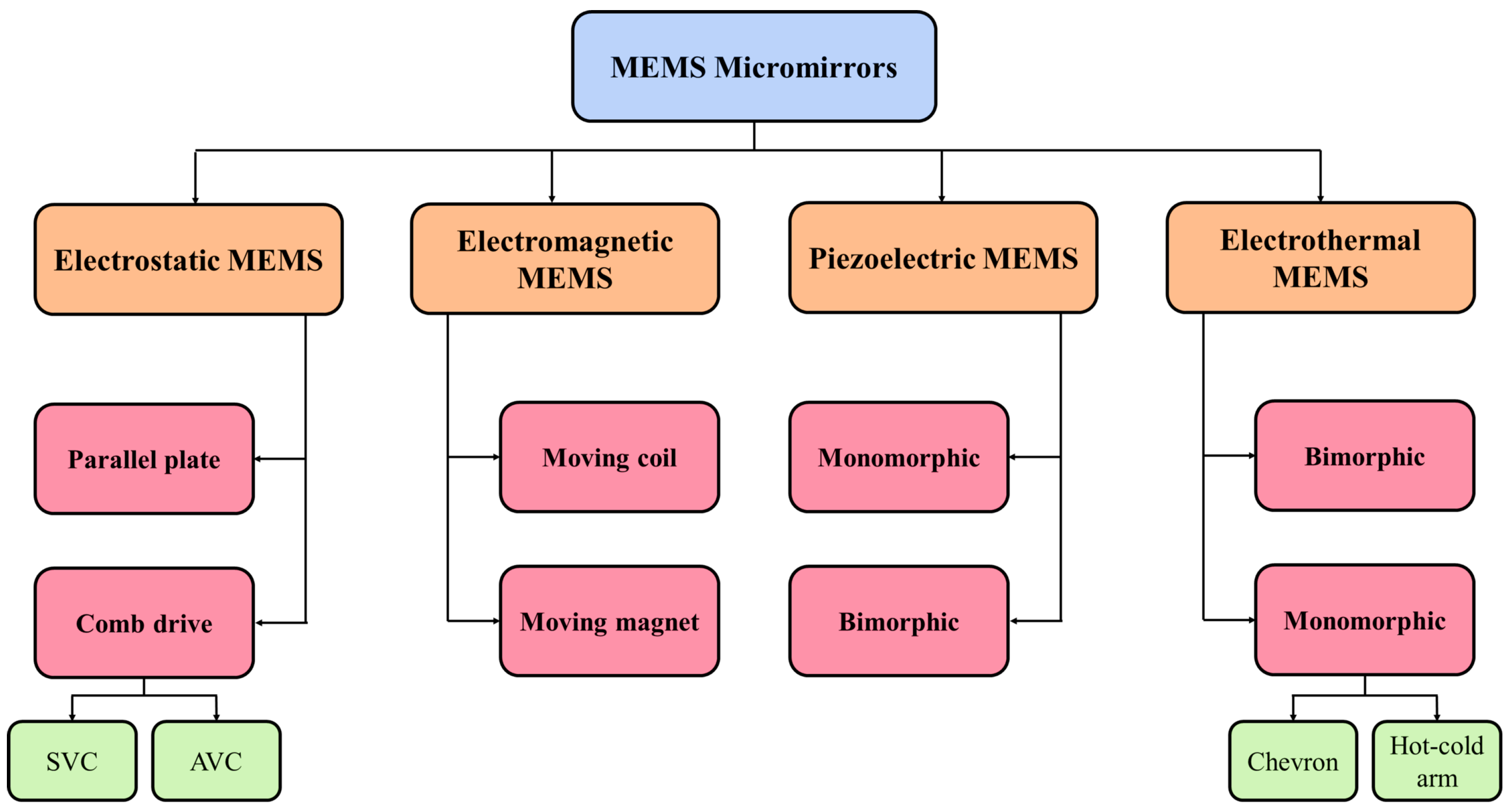
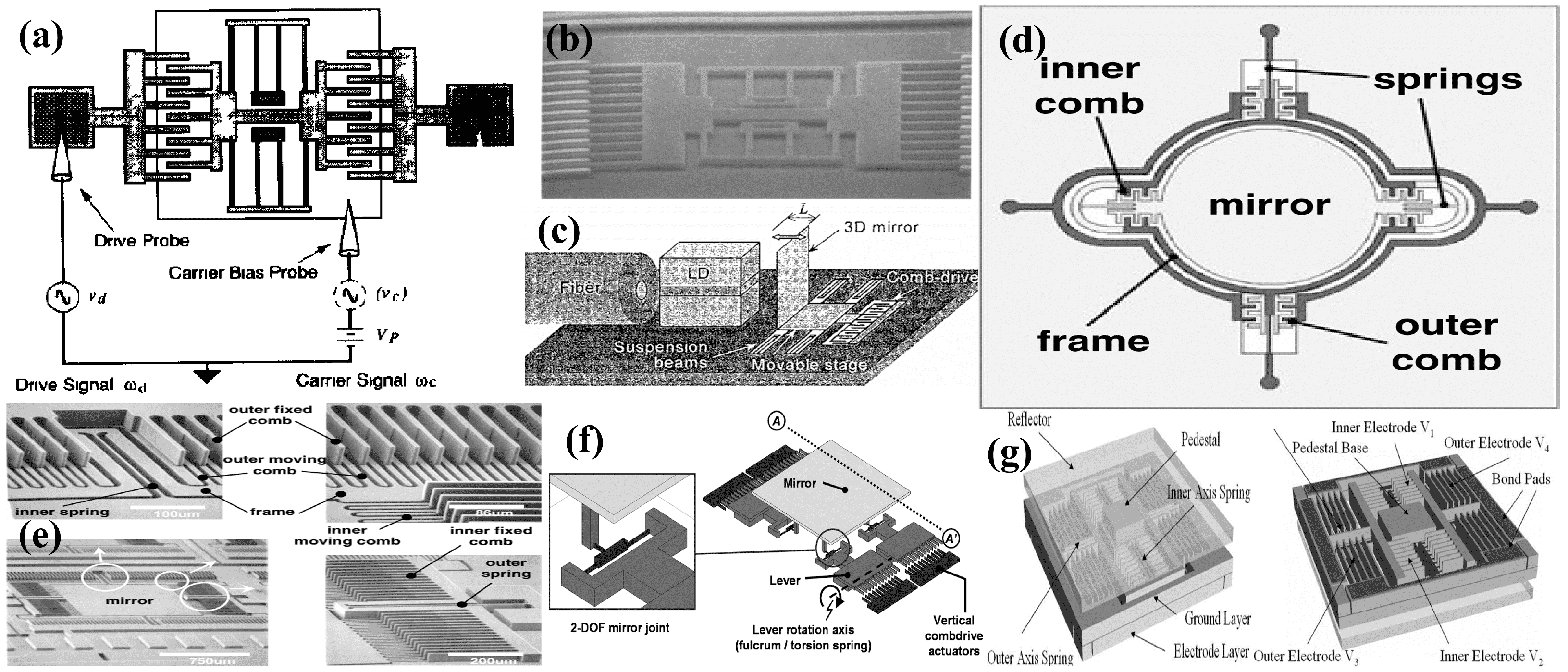
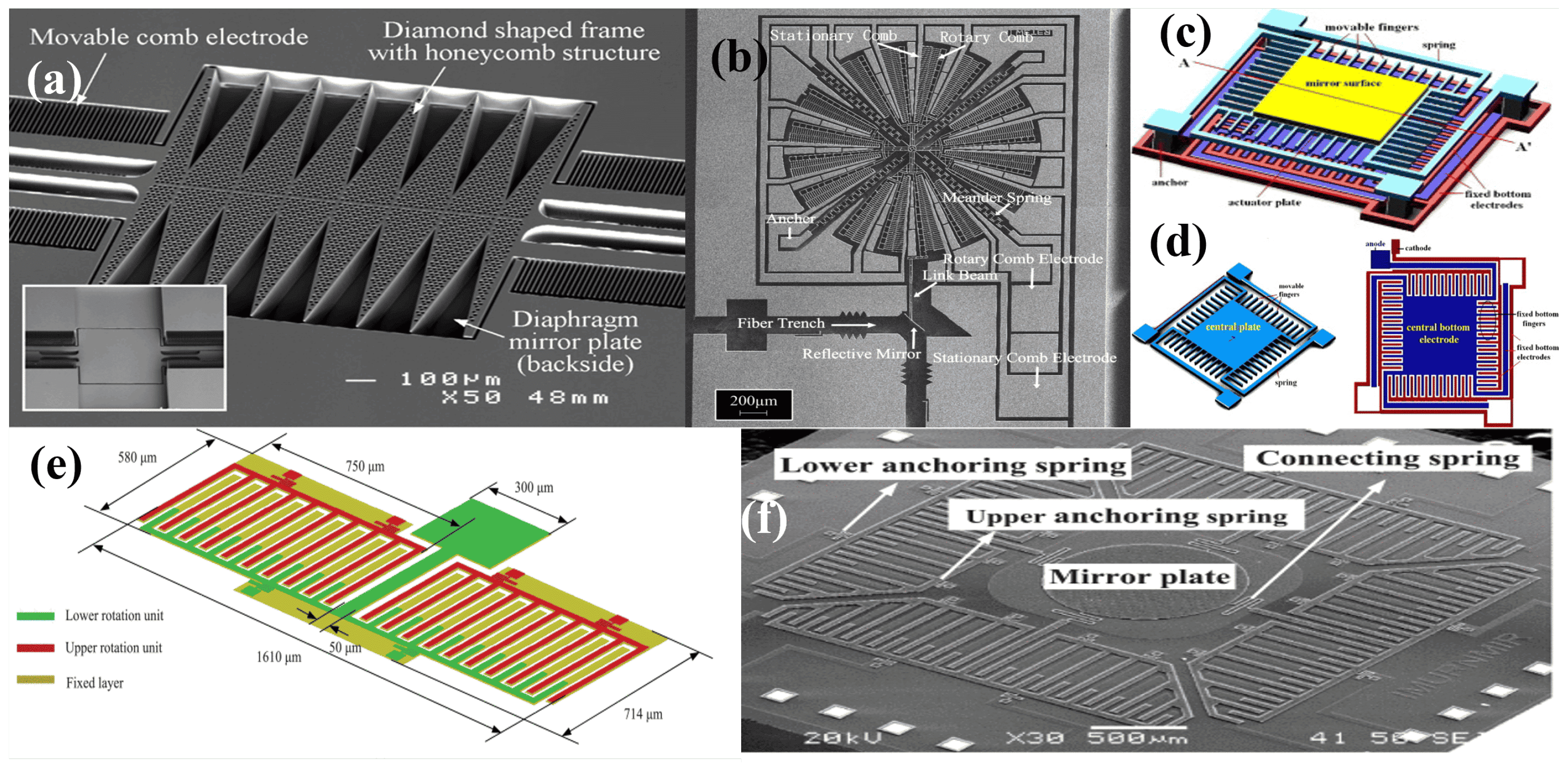

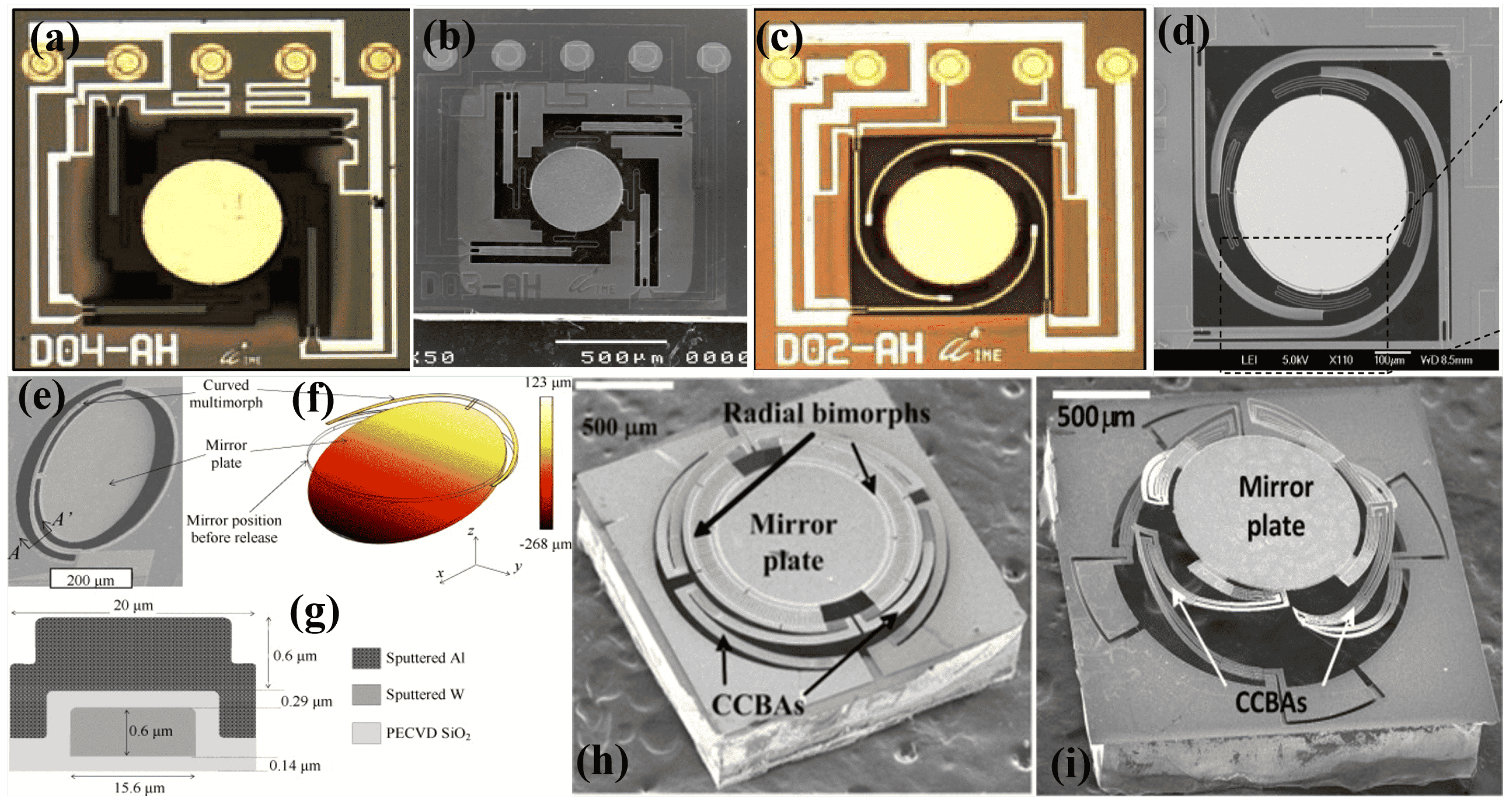
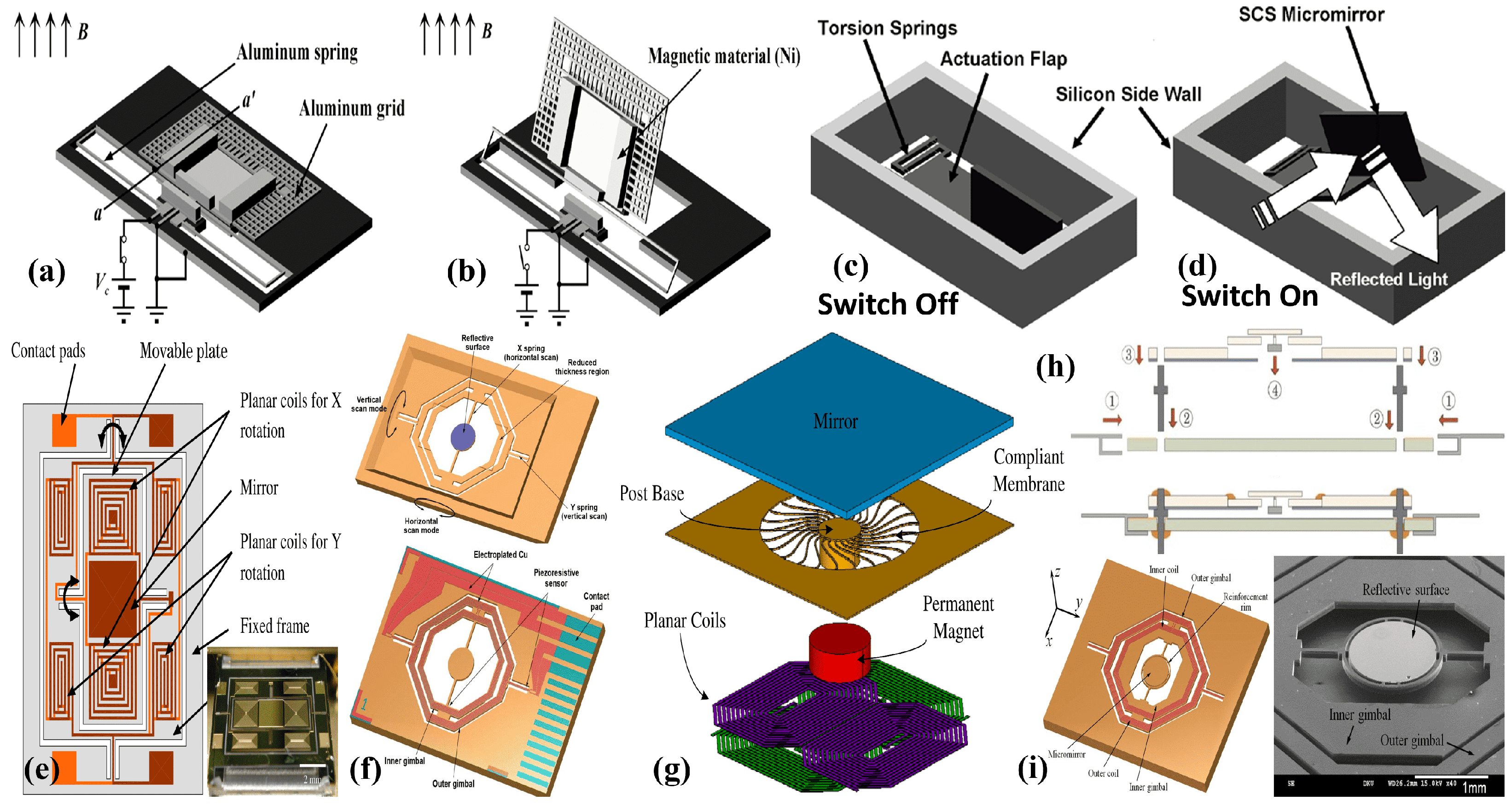
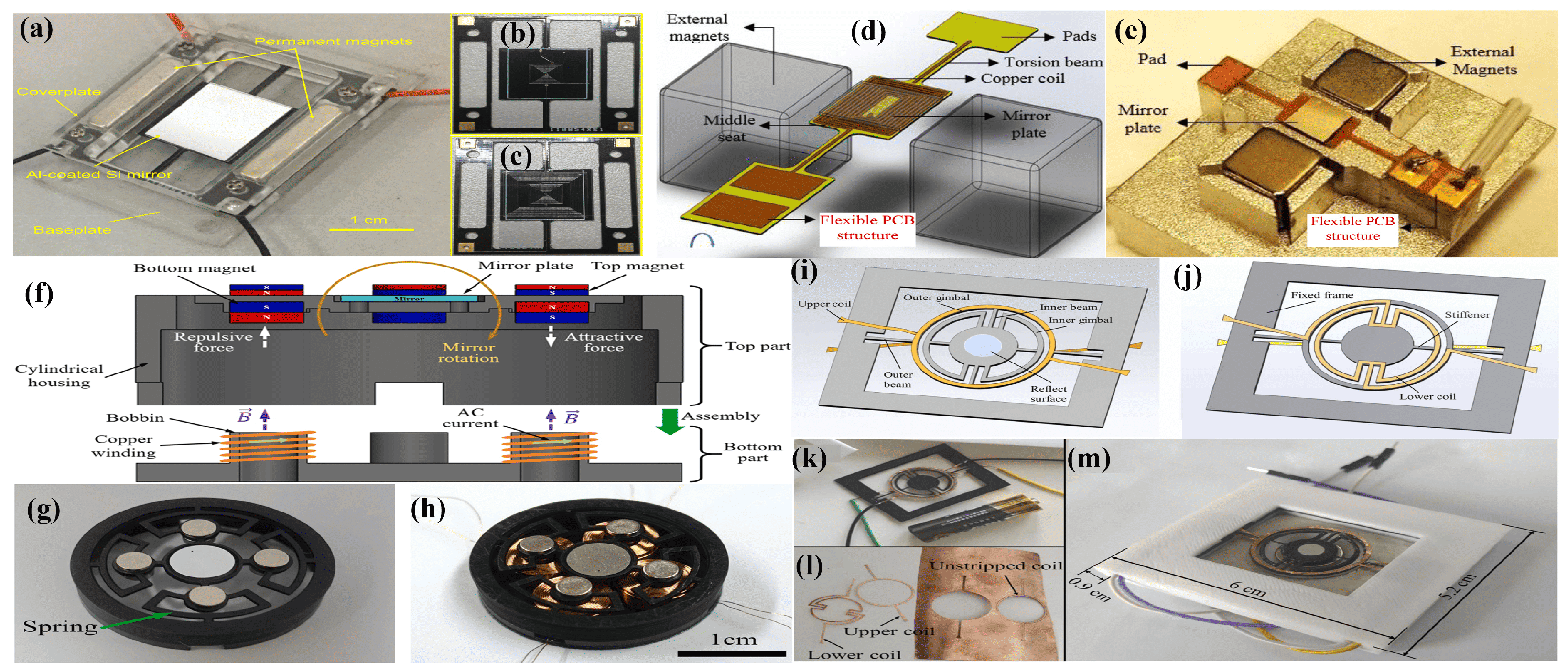
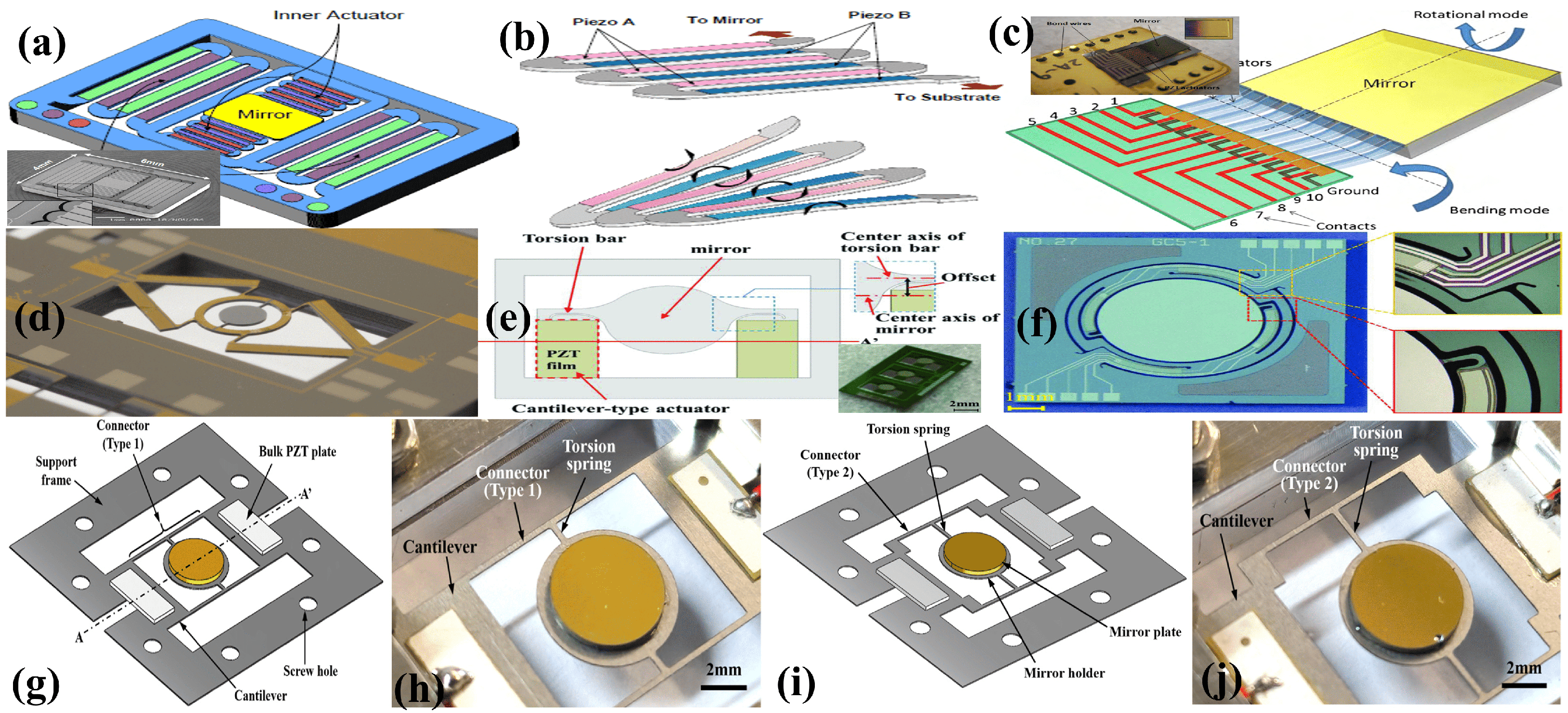

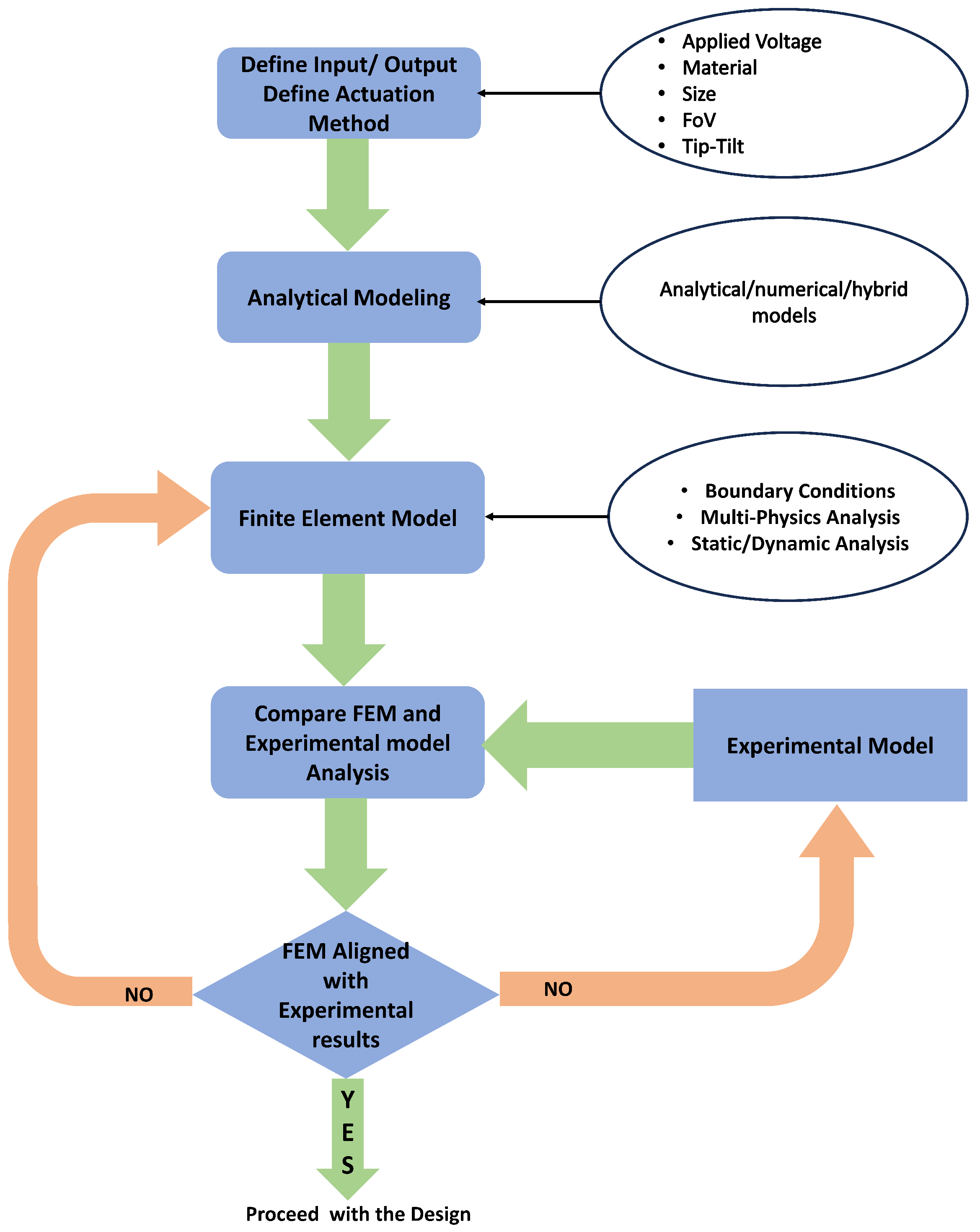
| Actuation | Mirror Type | Material | Voltage/Power | Stroke | Size | Ref |
|---|---|---|---|---|---|---|
| Electrostatic | 1D | nickel | 35 V | 10 m | 10 m × 10 m | [41] |
| Parallel plate | 1D | Al | 14 V | 0.3 m | 30 m × 40 m | [42] |
| 2D | polysilicon | 100 V | m | 400 × 400 m2 | [62] | |
| 2D | polysilicon | 150 V | 5 m | 400 × 400 m2 | [47] | |
| 2D | Al | 36.5 V | 25 × 25 m2 | [45] | ||
| TTP | Au | 23.1 V | m | 200 × 200 m2 | [21] | |
| ESA | 2D | polysilicon | 48 V | & | 1 mm2 | [71] |
| Combdrive | 2D | epitaxial Si | 40 V | 1.5 × 1.5 mm2 | [74] | |
| 1D | polysilicon | 100 V | 450 m | [70] | ||
| 2D | polysilicon | & | 650 × 650 m2 | [75] | ||
| 2D | Si repulsive | 60 V | m | 190 × 190 m2 | [96] | |
| 1D | CNTs | 5 V | – | [94] | ||
| 2D | Si repulsive | 150 V | 1 mm | [60] | ||
| Electrothermal | 1D | polysilicon-/Al | 4.8 mW | – | [118] | |
| 1D | polysilicon-/Al | 10 mW | – | [109,119] | ||
| 2D | polysilicon-/Al | 95 mW | – | [110] | ||
| TTP | polysilicon-/Al | 15 V | m | – | [111] | |
| 1D | Platinum-/Al | 12.5 V | – | [120] | ||
| 2D | Al/W | 0.68 V/11mW | 1 mm | [124] | ||
| TTP | Al/W | 0.6 V & 0.8 V | & 227 m | 1 mm | [125] | |
| Piston | Al/W | 0.9 V | 200 m | 1 mm | [125] | |
| TTP | Pt-/Al (FDS) | 8 V | m | – | [127] | |
| Piston | Pt-/Al (FDS) | 1.2 V | 90 m | – | [134] | |
| 2D | Pt-/Al | 5.5 V | 0.72 mm × 0.72 mm | [135] | ||
| TTP | /Al | 10 V | m | 1 mm | [137] | |
| Piston | Pt (LSF) | 5.3 V | 620 m | 0.8 mm × 0.8 mm | [130] | |
| TTP | Cu/W (ISCB) | 2.35 V | & 114 m | 1 mm | [143] | |
| TTP | Al/PSPI | 4 V | m | 1 mm × 1 mm | [145] | |
| Electromagnetic | 1D | polysilicon/nickel | – | 1mm | 450 m2 | [146] |
| 1D | nickel | – | 1200 × 1400 × 4 m3 | [148] | ||
| 1D | – | – | – | [149] | ||
| 2D | – | – | – | 500 × 1200 m2 | [155] | |
| 1D | – | 17.4 | 5mm | [14] | ||
| 2D | – | mA and mA | – | [156] | ||
| 2D | – | – | & | 1.2 mm | [5] | |
| 2D | – | – | & | 6.4 mm | [153] | |
| 2D | – | 5 V | & | 5 × 7 mm2 | [164] | |
| 2D | – | 400 mA | mm2 | [157] | ||
| 2D | – | 515.17 mA | & | 1.2 mm | [158] | |
| 2D | FR-4/Al | 425 mV | 11.6 mm | [167] | ||
| 2D | Polyimide | ±400 mV | 4 × 4 mm2 | [169] | ||
| 2D | ABS polymer | 0.2 | & | 6 mm | [173] | |
| 2D | ABS polymer/Cu | 0.9 | & | 10 mm | [174] | |
| Piezoelectric | 2D | PZT | 20 V | 1.0 mm × 1.5 mm | [176] | |
| 2D | PZT | 10 | & | 3 mm × 3 mm | [177] | |
| 1D | AlN | 5 V | 200 m × 200 m | [185] | ||
| 1D | AlN | 10 V | 6 mm × 4 mm | [186] | ||
| 1D | AlN | 20 V | 0.8 mm × 0.8 mm | [188] | ||
| 1D | PZT & steel plate | 5 mm | [184] |
| Actuation Method | Advantages | Disadvantages |
|---|---|---|
| Electrostatic | Fast response | High driving voltage |
| Low power consumption | Low drive force | |
| No heat dissipation | Pull-in effect | |
| No thermal effect | Nonlinear response | |
| Electrothermal | Low driving voltage | High power |
| Large scan angle | Heat generation | |
| High fill factor | Slow response | |
| High power consumption | ||
| Electromagnetic | Large scan angle | Large size |
| Low driving voltage | High power | |
| Large drive force | Need external magnet | |
| Better linear response | Large size | |
| Complicated fabrication | ||
| Large thermal dissipation | ||
| Piezoelectric | Fast response times | Small reflection surface |
| Low driving voltage | Complex fabrication | |
| Low power consumption | Large foot print |
Disclaimer/Publisher’s Note: The statements, opinions and data contained in all publications are solely those of the individual author(s) and contributor(s) and not of MDPI and/or the editor(s). MDPI and/or the editor(s) disclaim responsibility for any injury to people or property resulting from any ideas, methods, instructions or products referred to in the content. |
© 2024 by the authors. Licensee MDPI, Basel, Switzerland. This article is an open access article distributed under the terms and conditions of the Creative Commons Attribution (CC BY) license (https://creativecommons.org/licenses/by/4.0/).
Share and Cite
Ahmad, M.; Bahri, M.; Sawan, M. MEMS Micromirror Actuation Techniques: A Comprehensive Review of Trends, Innovations, and Future Prospects. Micromachines 2024, 15, 1233. https://doi.org/10.3390/mi15101233
Ahmad M, Bahri M, Sawan M. MEMS Micromirror Actuation Techniques: A Comprehensive Review of Trends, Innovations, and Future Prospects. Micromachines. 2024; 15(10):1233. https://doi.org/10.3390/mi15101233
Chicago/Turabian StyleAhmad, Mansoor, Mohamed Bahri, and Mohamad Sawan. 2024. "MEMS Micromirror Actuation Techniques: A Comprehensive Review of Trends, Innovations, and Future Prospects" Micromachines 15, no. 10: 1233. https://doi.org/10.3390/mi15101233
APA StyleAhmad, M., Bahri, M., & Sawan, M. (2024). MEMS Micromirror Actuation Techniques: A Comprehensive Review of Trends, Innovations, and Future Prospects. Micromachines, 15(10), 1233. https://doi.org/10.3390/mi15101233









